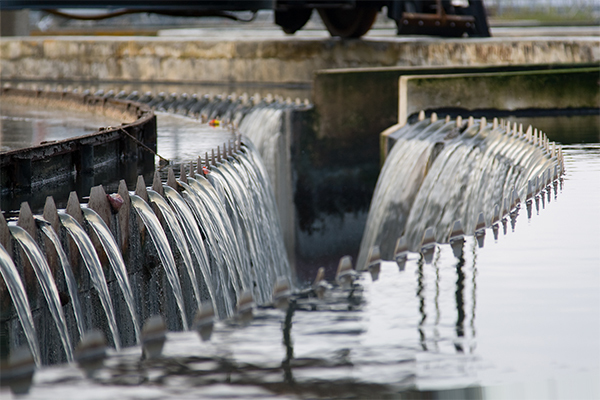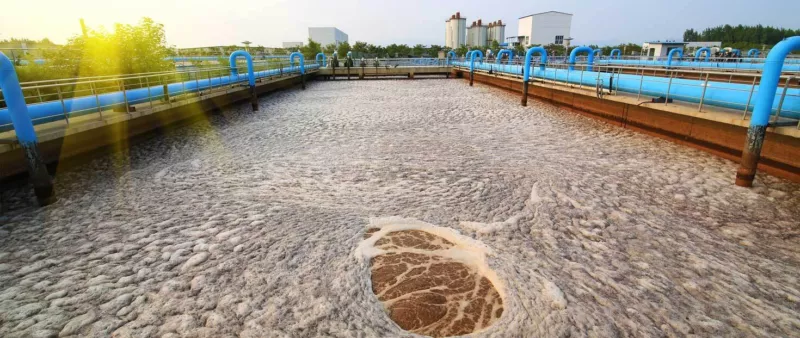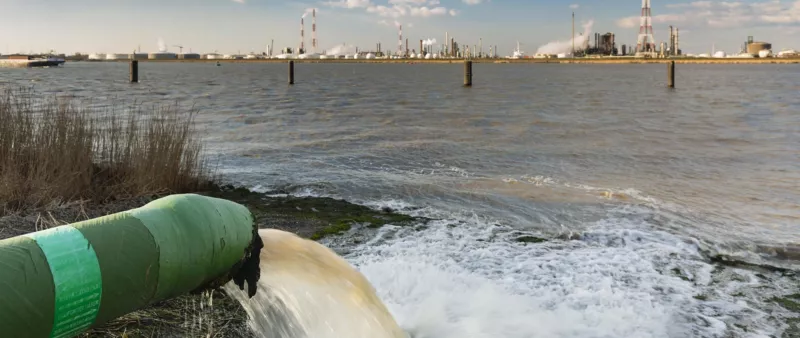A circular filtration solution to tackle WWTP emissions
Wastewater treatment plants (WWTPs) have to deal with a wide range of pollutants. These affect both water and air emissions. In this article, we’ll share a purification solution that can help WWTPs comply with environmental regulations in an eco-friendly and cost-effective way.
Purification scenarios for WWTPs
- Incoming streams from manufacturers: if the outlet stream of wastewater contains pollutants with concentrations above the WWTP’s acceptance level - which is the maximum concentration that a WWTP is legally permitted to admit - the producer needs to lower these concentrations. Therefore, a pre-treatment is needed before the stream can be accepted by the WWTP;
- Effluents: before being discharged, the treated wastewater might need to be subjected to a polishing step to lower the pollutants concentration even more. This is the case of a plant discharging their wastewater into a nearby river as it must comply with strict emission limits, or treating wastewater before reusing it for its operations. Another example could be odour removal following neighbours’ complaints.


An overview of the main WWTPs emissions
PFAS
Per- and polyfluoroalkyl substances (PFAS) consist of thousands of synthetic persistent substances and some already considered as Persistent Organic Pollutants (POPs). They may be short-chain or long-chain. The latter are the most persistent types of PFAS, which are also called ‘forever chemicals’. Many PFAS are considered carcinogenic, mutagenic and reprotoxic (CMR), therefore their removal from wastewater is paramount.
COD
Chemical oxygen demand (COD) includes a series of substances (both biodegradable and non-biodegradable), which can be removed via oxidation. These include pesticides, POPs, and many other pollutants. If not removed from wastewater, COD will harm marine wildlife. In addition to this, a high COD level could also disrupt bacteria in wastewater treatment biofilters.
AOX
Adsorbable organically bound halogens (AOX) are components containing chlorine, bromine, or iodine that are used in pharmaceutical, chemical, agricultural, and cleaning products. Most AOX are chlorinated, including dichloromethane (DCM), trichloromethane (chloroform), chlorophenols, chlorobenzene, etc. Some AOX components are not biodegradable. Among these are POPs such as polychlorinated biphenyls (PCBs) and dioxins.
Surfactants
Surfactants are compounds that lower the surface tension between two liquids or between a liquid and a solid. Here are the most common types of surfactants:

Odours
Aside from wastewater, WWTPs also generate odours from multiple sources: sludge storage silos or buffer tanks, dewatering sludge units, hall ventilation. Odour nuisance is caused by a series of chemicals such as dimethyl sulfide (DMS), aromatic hydrocarbons, hydrogen sulfide (H₂S), and ammonia (NH₄).
Activated carbon filtration, an effective technology for WWTP emissions treatment
The EU legislation recommends activated carbon as one of the best available technologies (BAT) to treat a wide range of pollutants contained in wastewater and air emissions. In addition to this, based on numerous successful projects over the years, DESOTEC has proved the effectiveness of activated carbon at removing all the contaminants mentioned above. To add to that, DESOTEC also has the expertise to select the most suitable activated carbon grade/mobile filter type combination to optimise WWTPs purification system.
Here are some of the advantages entailed by DESOTEC mobile filtration solutions:
- No CAPEX & lower cost: Buying a fixed filter implies a greater upfront investment (i.e., capital expenditure (CAPEX)) vs renting a mobile unit. In addition to this, fixed installations might no longer be suitable following production variations, contamination changes, or regulation upgrades. This implies purchasing another unit along the line, thus translating into further expenses.
- Greater flexibility: Tapping into a modular system will let plants purify their emissions while spending less money. All it takes is to add more mobile filters as needed. Moreover, DESOTEC’s plug & play mobile units can work either as a pre-treatment or polishing step downstream of the WWTP.
- Less downtime: Once saturated, the spent carbon needs to be vacuum extracted and the filter to be refilled with fresh carbon. While the exchange process of mobile filters takes just 30 minutes - as the whole mobile filter is replaced by a new one, with no onsite waste carbon handling - the carbon replacement of fixed installations is likely to take two workers up to multiple days, a costly downtime that many can’t afford. Furthermore, after being taken back, the exhausted mobile filter will be checked, thus not wasting any production time for maintenance purposes.
- More safety: Besides saving money, the off-site emptying of mobile units is also safer as it prevents operators from being exposed to hazardous waste and dust.
Closing the loop on WWTPs emissions
After years of R&D efforts, DESOTEC has brought activated carbon filtration to the next level. Besides using mobile units, DESOTEC has developed a first-of-its-kind plant in Belgium that turns spent carbon into a new activated carbon of equivalent quality to the virgin one.
Thanks to this circular innovation, DESOTEC’s activated carbon filtration can make purification:
- Cheaper: the saturated carbon is upcycled into a new adsorption media, thus reducing the cost of treatment.
- More resilient: raw materials shortages and tighter regulations could undermine the profitability of WWTPs. By upcycling a costly waste into a European-made activated carbon, DESOTEC is future-proofing plant operators.
- Greener: sourcing up to 80% less coal-based virgin activated carbon from outside Europe, DESOTEC is reducing its greenhouse gas (GHG) emissions. In turn, this means a more eco-friendly emissions treatment.
WWTP emissions treatment case studies
COD removal for the textile industry
Following an increase in production and changes in the manufacturing process, a client's biological WWTP was no longer sufficient to keep COD levels below emission limits (120 mg/l). After the customer reached out to us, DESOTEC ran a pilot test to begin with. These helped choose the best solution for their purification needs: 2 MOBICON 2000 filters in series filled with ORGANOSORB 10-AA. Once the filters went live, the plant became compliant again.
AOX removal in the automotive industry
Following an upgrade of environmental regulations, a WWTP in Portugal was no longer able to ensure compliance with the stricter AOX emission limit (0.4 mg/l). The plant manager contacted DESOTEC and asked for a rapid solution. As the contaminated flow (9 m3/h) contained suspended solids (80 mg/l), DESOTEC installed 1 MOBICON 2000 as a pre-treatment. Downstream of that, 1 MOBICON packed with ORGANOSOB Plus was dedicated to the removal of AOX.
Removing surfactants from wastewater at a chemical company site
Because of an unexpected presence of surfactants (ca. 20 mg/l) in the wastewater of a chemical company, foam formed in the oxidation tank of the treatment plant. Furthermore, the surfactant level was above the concentration that could be accepted by WWTP, meaning the company had to stop production until it found a solution. This was an emergency scenario and the customer required a prompt solution. DESOTEC immediately delivered and installed 1 MOBICON filter packed with ORGANOSORB 10 AA. As a result, the surfactant level met the acceptance limit from the WWTP and production resumed within 48 hours.
Removing PFAS from water at a waste management site
A WWTPs manager reached out to DESOTEC to reduce the PFAS level in their wastewater from 732 µg/l to the drinking water limit (100 ng/l). DESOTEC installed two filters in series: the first one to remove COD and larger PFAS molecules; the second one to adsorb smaller PFAS molecules such as perfluorobutanoate (PFBA), perfluorobutanesulfonic acid (PFBS) and trifluoroacetate (TFA). After implementing this two-step solution, the customer became compliant with the drinking water regulation.
Tackling odour nuisance in air emissions from WWTP
A WWTP in the Netherlands received odour complaints from neighbours. Therefore, it needed to treat air emissions from the hall ventilation (high flow, low concentration of sulfuric components) as well as those coming from sludge mixing and storage (low flow, high concentration of inorganic compounds).
For the hall ventilation, a DESOTEC AIRCON filter was enough to treat the odorous components. As concerns sludge mixing and storage units, a two-step filtration process was put in place: a) biofilter for ammonia removal; b) another AIRCON filter to remove remaining odours.
Thanks to our intervention, the plant stopped receiving any complaints from neighbours, and could continue to operate smoothly.
How DESOTEC can help
As a pre-treatment or polishing unit, be it wastewater or air emissions, WWTPs and producers sending their wastewater to WWTPs can leverage activated carbon filters to comply with environmental limits in a cost-efficient manner.
Contact our expertsHow DESOTEC can help
As a pre-treatment or polishing unit, be it wastewater or air emissions, WWTPs and producers sending their wastewater to WWTPs can leverage activated carbon filters to comply with environmental limits in a cost-efficient manner.
Contact our experts-
COD & BOD
By complying with BOD and COD limits, firms ensure that waterways and WWTP biofilters remain healthy -
Waste and wastewater management
Sustainable air and water purification for waste management and recycling to protect our environment and control odours. -
Our filtration solutions
We offer a wide range of filter models and carbon grades to suit your industrial water or air purification requirements.
Related content
-
Purifying wastewater of PFOS and other PFAS
Combat the threat of PFAS contamination with DESOTEC's sustainable filtration solutions, ensuring regulatory compliance and safeguarding environmental and human health. -
Removing non-ionic surfactants in wastewater
Non-ionic surfactants are widely used in industry during production and cleaning processes. They can be found in lubricants, waterproofing materials, foaming or anti-foaming agents, disinfectants and detergents. Activated carbon is a highly effective method of treating wastewater containing non-ionic surfactants, allowing it to be discharged safely. -
Tackling odour nuisance in air emissions from wastewater treatment plants
Wastewater treatment plants (WWTPs) are vital components of our infrastructure – yet they often create odour nuisance for those living nearby. In this article we will discuss common problems and effective solutions to remove odorous components from emissions. -
Reducing wastewater COD levels at plastic recycling company
For a client who recovers and recycles plastic boxes, mainly from the food industry, DESOTEC provided mobile activated carbon filtration solution to help reduce wastewater COD levels, enhance sustainability, and scale our customer's operations.






